

 |
 |
My plans for the night of September 13th/14th actually began late the previous week on Thursday night at which time I was occupied with looking into the month ahead in search of exciting sky events which I could capture on camera. One of my favourite night sky phenomena are moonbows - sometimes called lunar rainbows or nocturnal rainbows - which are a very rare and elusive type of atmospheric transient subject which most people have never heard of before with many professional meteorologists and astronomers included in that category. Moonbows are essentially a rainbow which is visible at night and caused by moonlight rather than sunlight, regular visitors to the website will have encountered this subject numerous times in the form of image reports and educational articles I have featured so you will certainly be no stranger to this eerie phenomena. There is plenty of information available here to learn more about the topic however for those new to moonbows I will briefly explain the specific requirements needed to catch one.
To see the most spectacular moonbows you need to be watching on a night when there is a very bright moon in the sky which means the period around full phase is your best time during each month. In theory moonbows can be generated by even a weak moon phase which I have witnessed many times however the best period surrounds the full moon with my favourite time being the gibbous phases 1 to 2 days after full when the moon is in the evening sky and rising in the E. It should be made clear that the moon needs to be less than 42 degrees above the horizon in order for a moonbow to form, if the moon is higher then you should return home or spend your time on some other night sky subject until a more favourable time. Next you need the correct weather conditions and this is the crucial factor because you need regular night time showers which are essentially non existent or rare in certain parts of the world so in this aspect N. Ireland is a fabulous place to be thanks to our very wet climate dominated by the Atlantic Ocean.
By far the best time to look is after a cold front has passed through when the air is nice and clear with scattered showers in its wake with night showers in this country typically moving in anywhere from W to N during the Autumn and Winter months. With the moon less than 42 degrees high behind your back and you looking directly opposite to the anti-lunar point you will be sure to see a moonbow if precip from a shower moves into that sector of sky. The appearance of the moonbow will depend on the size and quality of the rain drops, the distance between precip and observer, and the subduing effects of cloud over the moon or over the opposition point. The height of the moon and its phase and distance from Earth will also play a role in how spectacular the bow will be. As you can imagine, getting all these conditions together at the same time doesn't happen very often so the would-be moonbow hunter should be a very experienced observer with a thorough knowledge of the moon cycles and local weather patterns combined with an abundance of dedication and passion.
On Thursday night, looking ahead to the following Tuesday, I noticed that the long range weather forecast was predicting an unsettled period of weather dominated by the Atlantic in the form of several deep depressions with significant wind fields and associated fronts and troughs which certainly looked interesting this far out, furthermore the Met Office website was going for night time showers over Ulster on Tuesday night so things were looking good as the Moon would be just one day after full and rising in the E when the sky got dark. Tuesday night came and everything looked good on the radar with a cluster of showers passing through after sunset, when night fell all I could see was a dark sky with rain falling for what seemed like a long time, the local tv forecast were going for a cloudy night which concerned me as cloud cover is your worst enemy so I kept glancing outside waiting for nature to synchronize and lure me out. I looked out my upstairs window which faced E and saw a crack in the cloud cover with bright moonlight fanning out, I quickly moved to the other side of the house and checked the window facing W and saw a clear bright sky filled with twinkling stars and I could sense that a moonbow was about to happen so I rushed down stairs, grabbed some warm clothes, and ran out to the car.
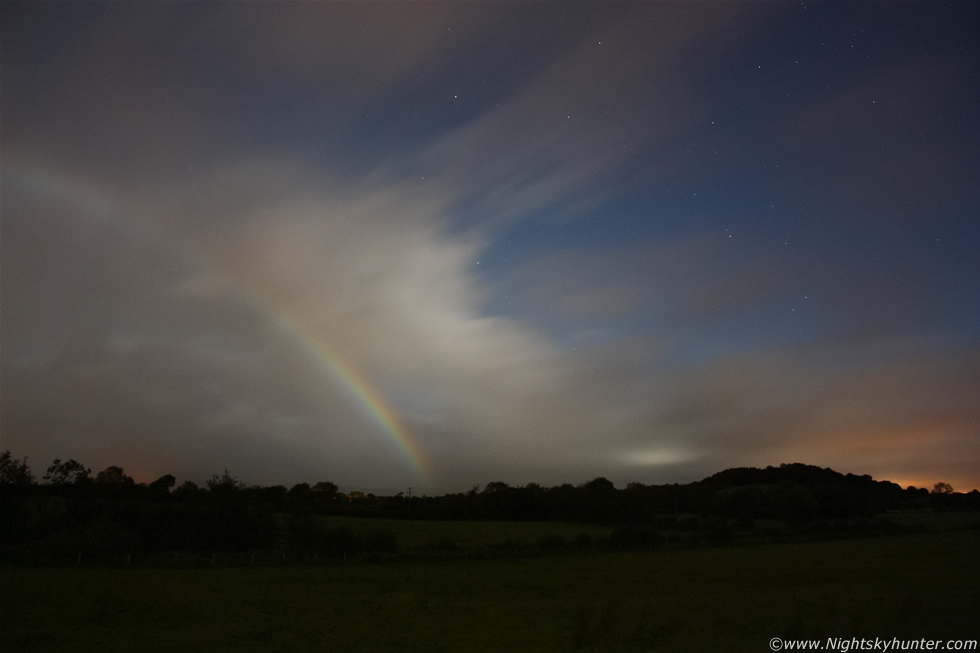 |
21.55 BST. As I climbed into the car I caught a glimpse of white cloud tops miles away to the W moving in and I knew that a moonbow was going to happen any minute - if not already visible - so I drove away from the lights and into the dark Maghera countryside and parked at the bottom of the road at one of my old-faithful locations which I use on a regular basis. I quickly extended the tripod to full height, attached the camera - the settings were already sorted out during daytime hours - and focused the camera on infinity using Capella which could be seen easily in the live view LCD screen at low magnification which was a testament to the clarity of the night. I then climbed over an old gate and walked into a large field while getting drenched by the rain-soaked grass and as my eyes adjusted to the dark I looked to the W and saw a big line of convective showers over the Sperrin Mountains with gorgeous white tops illuminated by the moon which was behind me to the E peaking out from behind a shoal of clouds 'swimming' past the moon. While I set the tripod on the grass I could make out a strange form which reminded me of a white diagonal line cutting down through the moonlit clouds like the slash from a Samurai sword, I pointed the camera in that direction and took my first exposure of the night, when I previewed the image on the screen I was overjoyed to see a moonbow, that's what that diagonal slash had been, success had been quick, literally within seconds of activating the shutter. The above image was my first catch of the night with the stars of Ursa Major in the frame.
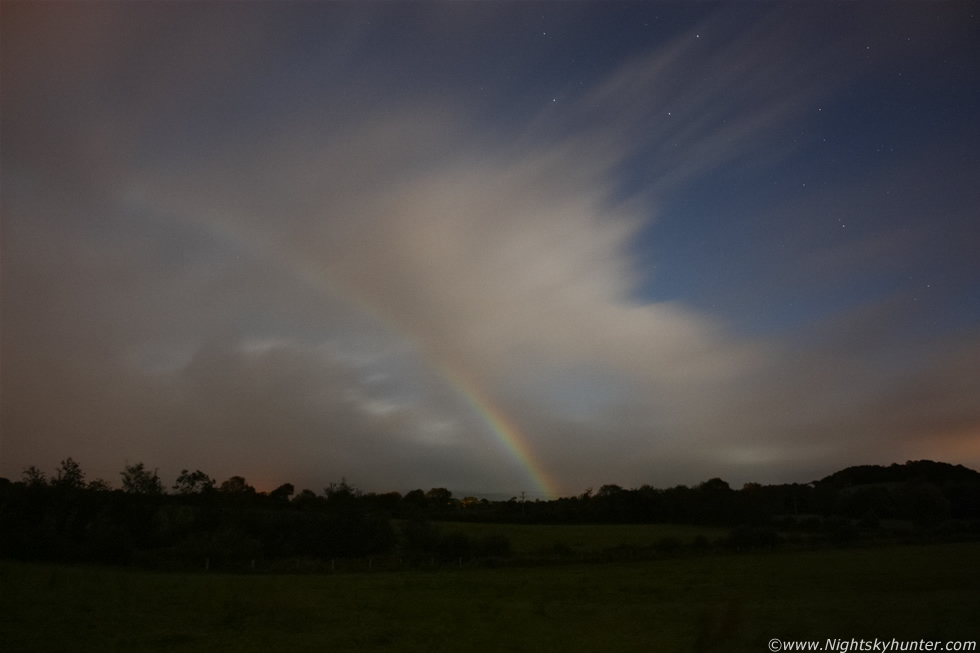 |
21.55 BST. Same moonbow approx 30 sec's later. I could see the bow easily with the dark adapted naked eye however I could discern no colour at this time. I just kept shooting the bow and took a quick break between exposures to wipe the lens dry because there was a flurry of precip drops hitting the lens from this distance. Soon the cloud and precip where over me and I wondered if this would be the only one of the night, however not one for giving up easily I decided to hang around and see what else happened.
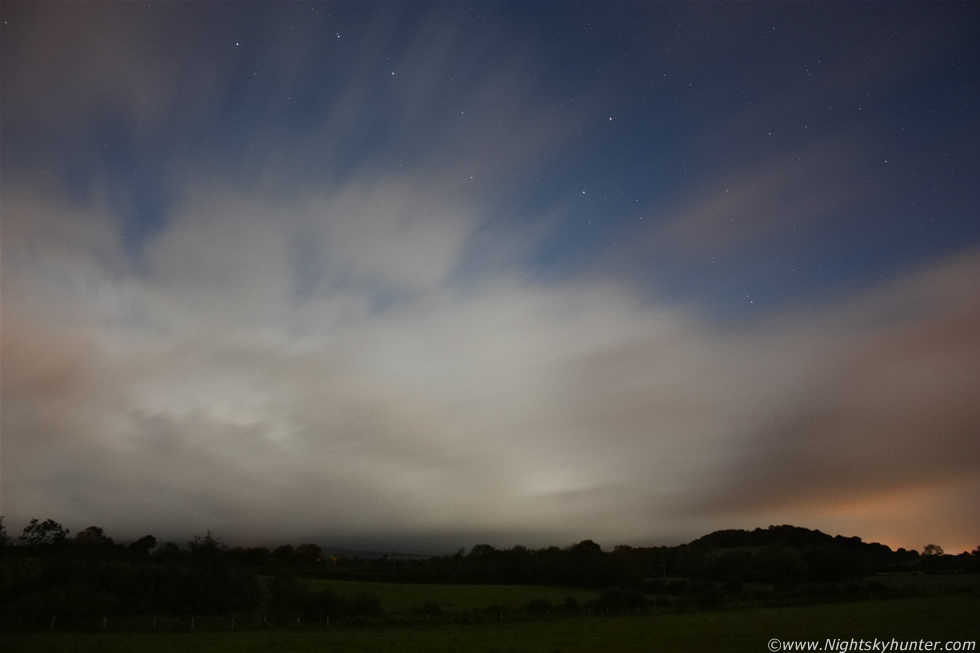 |
22.10 BST. The shower passed behind me into the E covering the moon but it wasn't long before the sky cleared and the stars returned. It was around this time that I began to get a good feeling that this was going to be one of those amazing nights to look back on so I eagerly waited for the next moonbow. This is the view looking due W over the Glenshane Pass and Sperrins towards another line of convective showers which where blowing towards me from W to E (towards camera), the clouds were very low to the ground and looked quite sinister visually and below was a feature which was likely a weak gust front/outflow structure. I checked behind me and the moon was breaking out from the scudding clouds which suddenly lit everything up all around me, I knew once that line of showers approached I would be in action yet again so I began taking more exposures before I could even see anything.
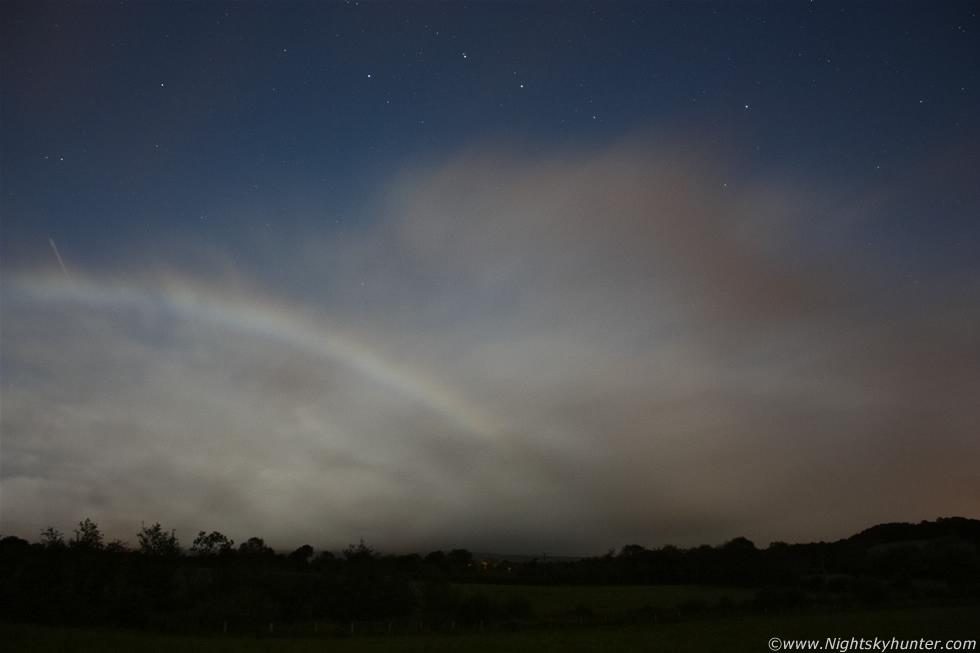 |
22.16 BST. Like clockwork a moonbow suddenly formed along the leading upper portion of the shower line and this time I could see the colours with the naked eye, that's the light trail from a high altitude passenger plane going to America passing above the top of the bow.
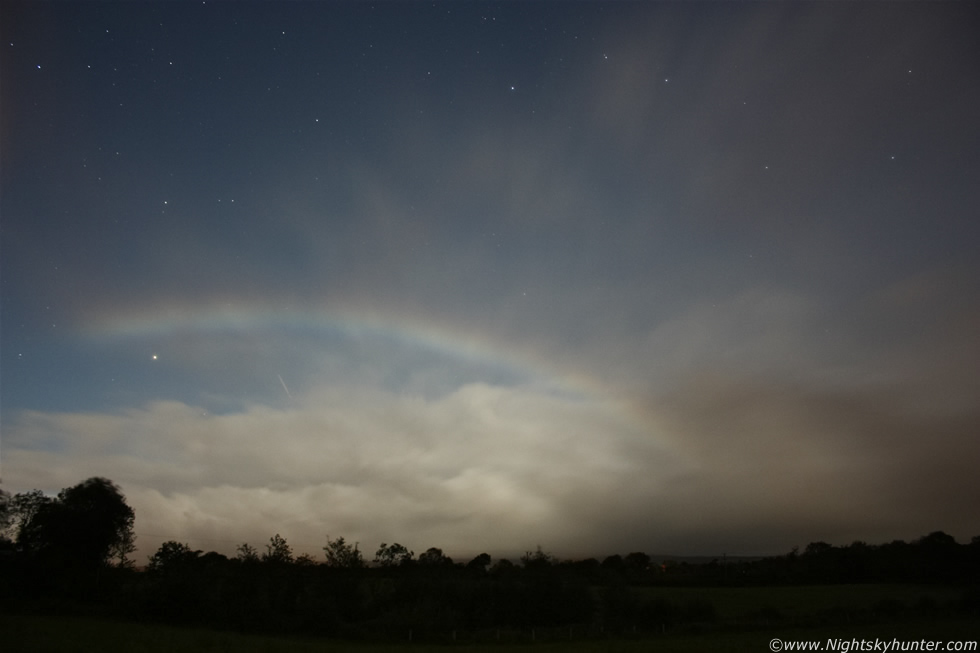 |
22.17 BST. You can see that the actual line of shower clouds is still some distance away while it was dry here yet a moonbow had formed. This was because the winds aloft had blown the precip and lighter clouds down-range from the main bulk of cloud which is an ideal set-up for any moonbow hunter. This means that the moonbow will often form against that wind-blown precip against a clear sky filled with stars allowing for a much more photogenic scene. If this wasn't the case with calm winds, or a sky with more cloud, then the bow would form against a dark cloudy background with little or no stars and the end result will be a dull low contrast uninspiring image which will sport a strong orange-red colour due to the ambient light reflecting on the precip which is highly undesirable. I have experienced the former scenario alot over the last two years while hunting for these nocturnal bows and more often that not the results were far from spectacular, however this night was exceptional and had great potential for photography so I decided to stay where I was until the moon rose higher than 42 degrees. Above the moonbow is Ursa Major with Bootes and Crb to the upper L, the bright star below the bow is Arcturus.
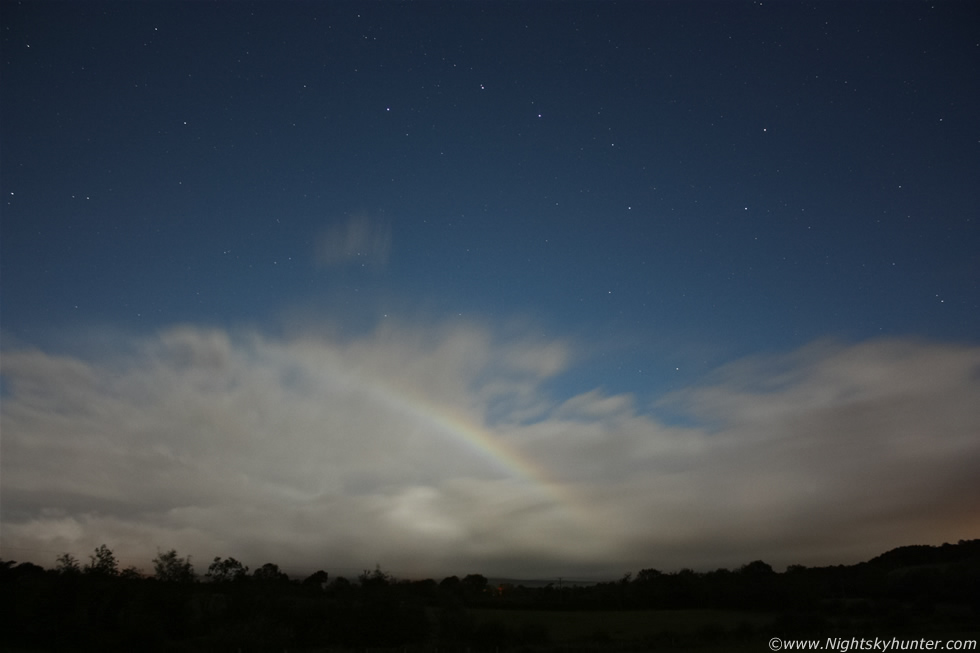 |
22.20 BST. The previous bow vanished as suddenly as it had appeared then the more substantial line of cloud behind it approached closer generating the third moonbow of the session. It was obvious by this stage that by great fortune I had chosen a night with the absolute perfect ingredients for vivid moonbow formation because not only was the moon in an ideal location but the weather was also perfection personified because I was being treated to a train of shower cells which where passing through the W portion of the sky exactly through the lunar opposition point. This meant that there would be showers moving through this sector back-to-back for several hours with the result that I could get non-stop moonbows for the entire window period when the moon was still less than 42 degrees high, this really was text book stuff and the likes of which I haven't seen since July 2008. This bow was only a partial however it was an easy naked eye sight with colour and it looked fabulous against the clean moonlit sky with stars aloft.
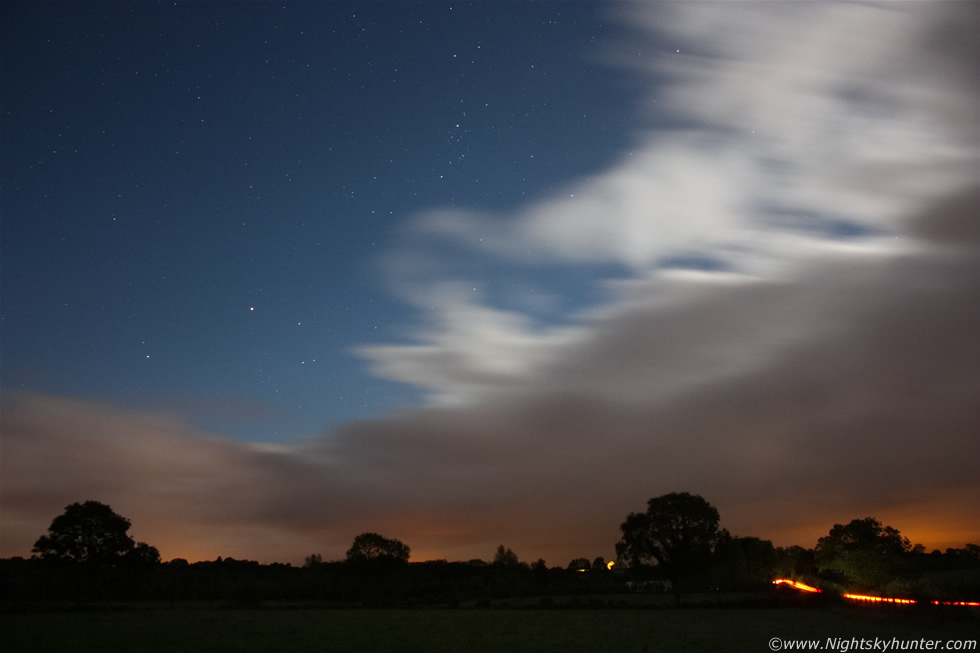 |
22.23 BST. This was looking NE at the back of the shower line as it was clearing through to the E (R) with the constellations of Auriga and Perseus on view with bright star Capella. I looked back to the W (L) and saw another line of convection in the distance drifting in which looked wonderful lit by the full glory of the moon. I knew that more moonbows would be appearing soon and with the moon higher in the sky free from the obscuring effects of haze and atmospheric extinction it would be much greater in brilliance and capable of producing even brighter bows so I got ready with my finger on the remote shutter.
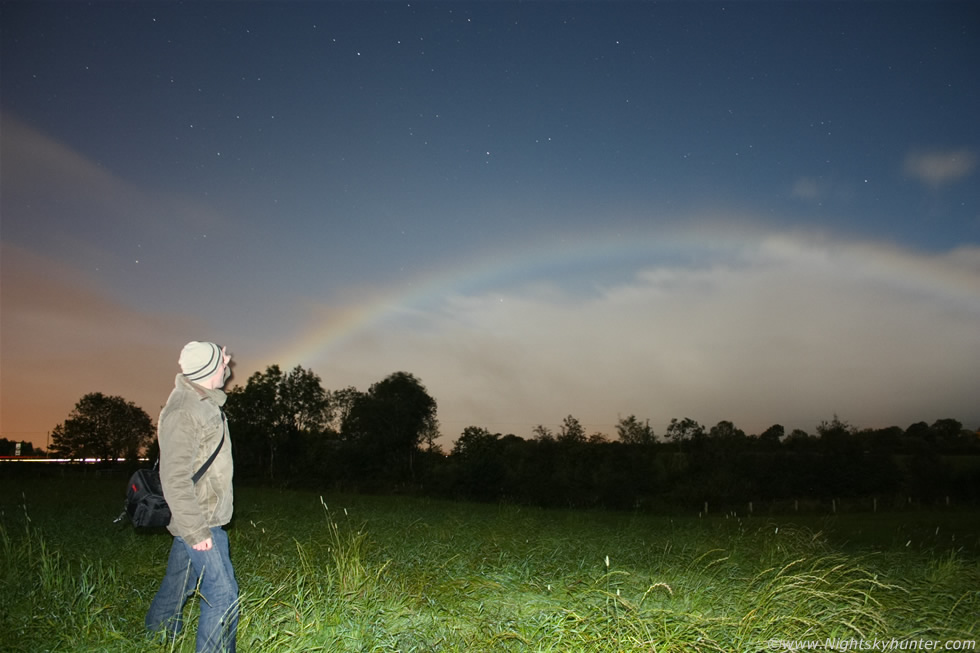 |
22.40 BST. The moonbow which followed turned out to be one of the very finest specimens I had ever witnessed in my life. This bow was bright and complete with brilliant red, yellow, and blue colours visible to the naked eye. In the above image it had only just appeared and despite being bright it was nowhere near it's full splendor. It was hanging around for a long time so I took the opportunity to stand in for a few images to personalize the event.
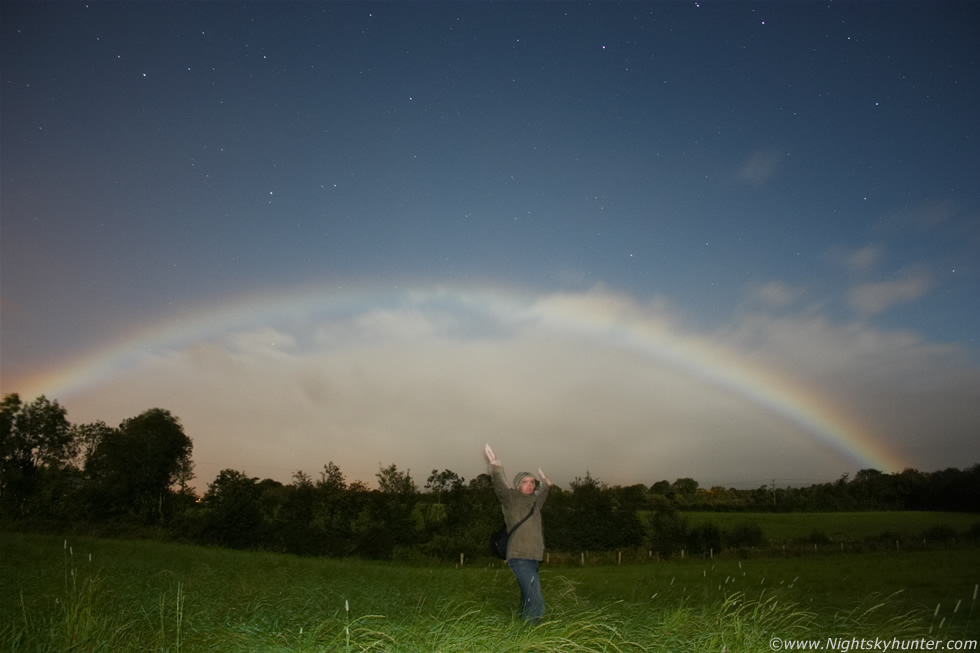 |
22.41 BST. I was having a fun time jumping around the field like an idiot, I don't know what I was trying to do in this image but I was enjoying myself anyway. Moonbows are so rare that when an excellent example comes along it's hard to resist the temptation to stand in the frame to make a memorable moment to look back on. The stars above belong to the N and NW sectors so had there been a bright aurora this night I would have had a moonbow and aurora all in the same frame which would have made for an incredible image.
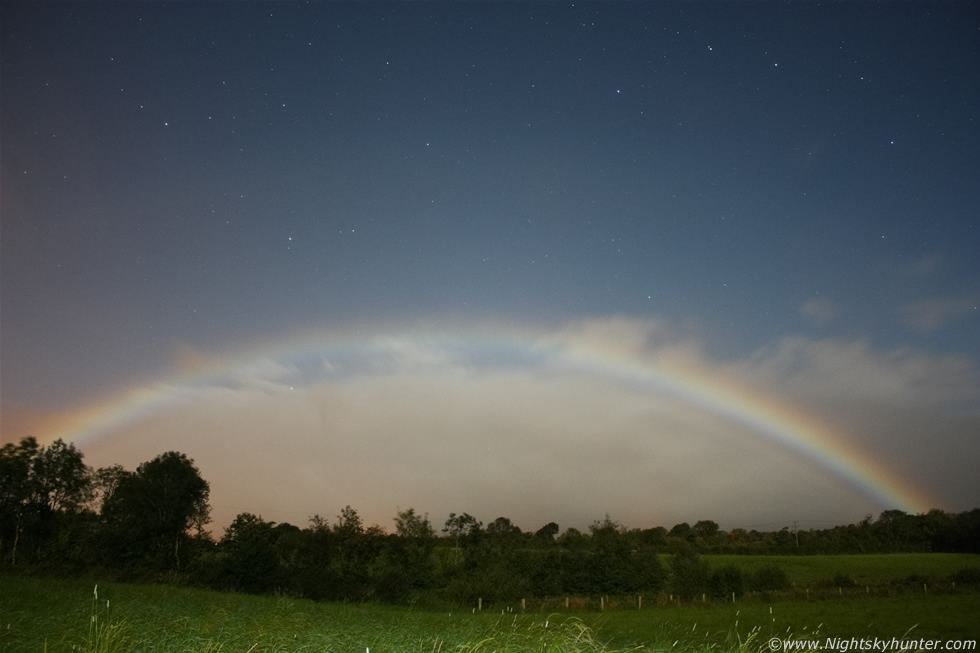 |
22.42 BST. Same scene without me standing in. The bow was now very bright with each base beginning to surge in magnitude, look to the base on the R and you can see the lunar version of rare supernumerary arcs on the underside of the band, these very fine delicate lines below the purple/blue band can be seen on a high quality daytime bow normally sporting striking green and pink colours however here you can still see their subtle structure with a hint of colour.
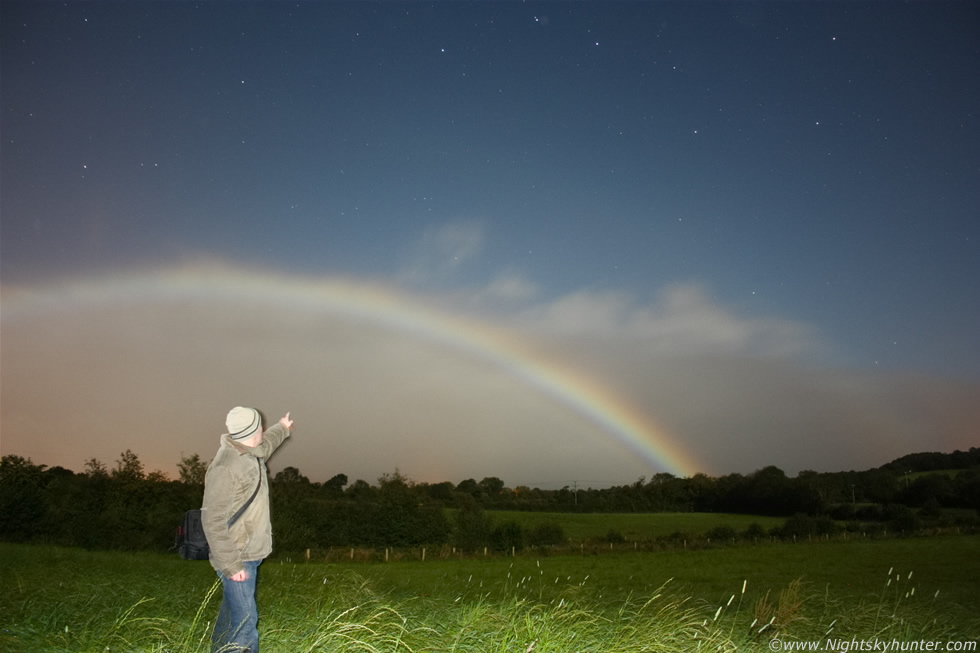 |
22.43 BST. One of my favourite images from the night. This image and the images below are among the finest moonbow captures I have ever taken so I was delighted beyond words with the way this night had turned out. In my opinion this is the way moonbow images should be - bright primary and complimentary secondary bows with supernumerary arcs and a clear sky with stars above. The fainter secondary bow (with colour) is visible to the far RHS near the Paws of the Great Bear.
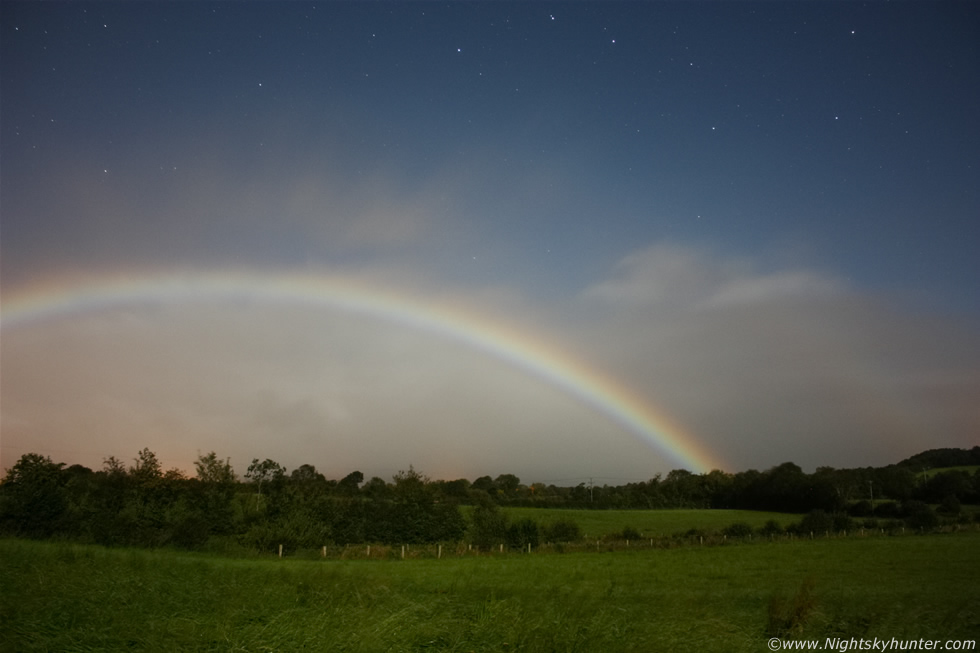 |
22.45 BST. Beautiful scene, it felt utterly surreal standing in this field among the wet grass with nothing more than a gentle breeze for company as the moonlight illuminated the field around me in its eerie waxing and waning light (from passing clouds) and the strange half-tone colours with made everything around me look pastel grey and charcoal with the naked eye with just a hint of colour like standing on a silent moon with colourless grass with my shadow projected across the field in front of me and glowing LCD screen being the only modern thing in my environment. Above all this was this majestic phantom of a bow jumping out from the sky in high contrast form and colour extending across the entire sky in front of me with the L base to the SW and R base to the NW with the circumpolar stars adding the celestial icing on the cake. The sight of that ghostly bow against the stars looked incredibly alien and I cherished every second of its performance, most moonbows are fleeting affairs however this one seemed to last for an astonishingly long time, long enough in fact for me to send several text messages to my girlfriend to let her know what I was seeing. Standing there I felt like I was detached from reality somewhere between two worlds where time stood still - I was fully caught up in the moment - a feeling which I love to experience with sky action, I actually held my fist high in the air and shouted ''yes!!!''.
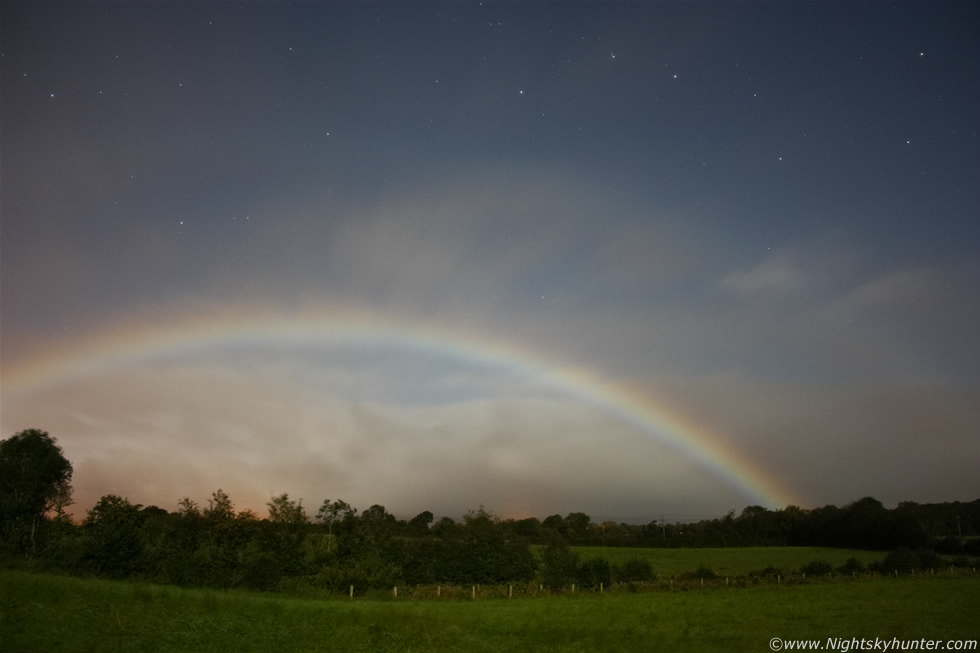 |
22.46 BST. Still the same moonbow, if you look carefully you can make out the secondary band extending across the clear sky through the stars above the primary. These were all taken with the 18mm kit lens so I can only imagine the results I would have got with a faster wide angle lens.
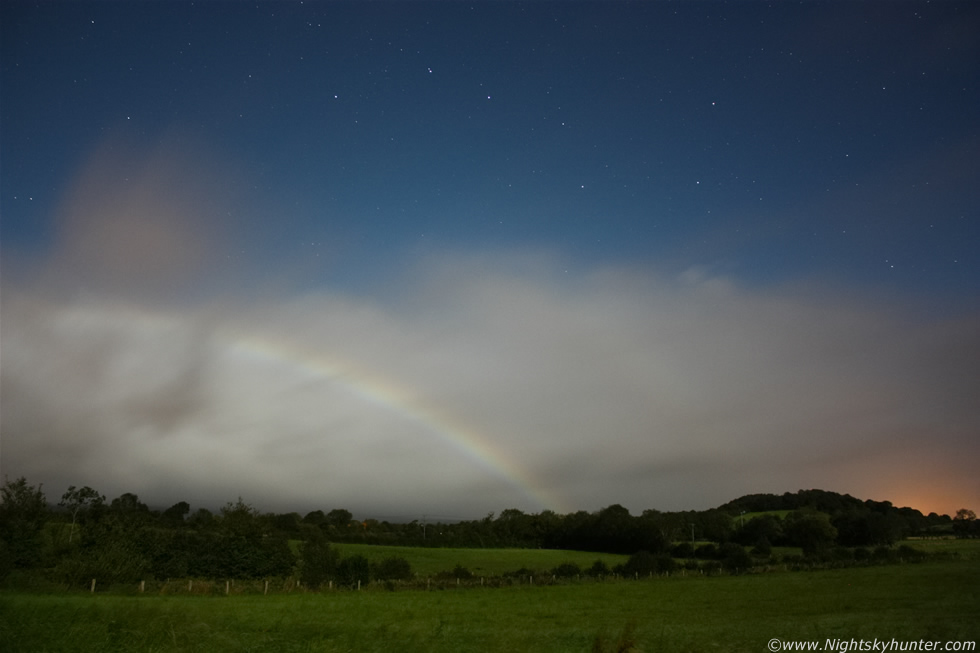 |
22.55 BST. 10 min's later a new line of showers moved in producing another beautiful moonbow set which was extremely photogenic. I was pleased with the structure in the clouds and within the primary bow, a faint secondary can also be seen to the RHS within the cloud.
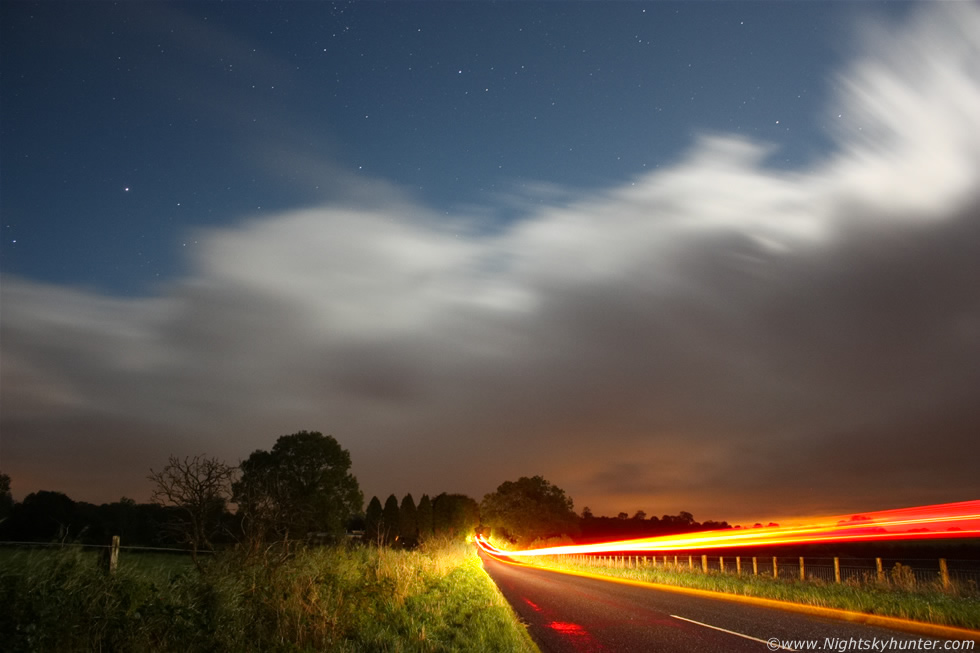 |
23.08 BST. I relocated to the country road and took this exposure of the back of the moonbow-producing shower clouds as they passed into the E with gorgeous moonlit cloud tops with the stars of Auriga, Perseus, and Triangulum above. The car trail added to the scene and came along at a convenient time as it was only one of several to drive down this road during the course of the session.
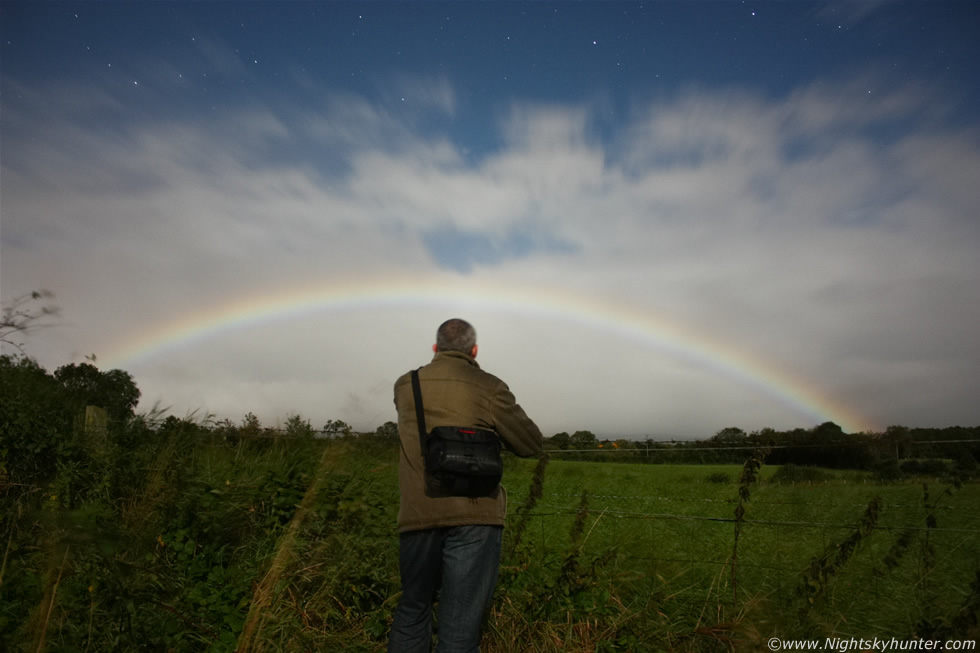 |
23.11 BST. One of the last captures of the night, I set up the camera on the quiet country road and used the remote shutter to take this farewell image of me leaning on the wire fence around the field I was just in and having one last look at yet another moonbow which had just formed. I ended the session just before 23.30 BST and as I drove along the road home I saw another bow through the front windscreen of the car which was a stunning sight to end the adventure. During that 1.5 hour period I had observed and photographed seven sets of long duration moonbows and came back with over 40 images which is by far a new personal record for me.
Lunar rainbows remain my favourite specialist optics phenomena and I intend to hunt them down and catch them on camera as much as I can in the months and years ahead. I have spent many nights spread over the years in all weather conditions (usually feeling cold, wet, and tired) at all hours of the night in search of these elusive bows however this session was without question my most productive harvest to date and almost on par with the magnificent bows I witnessed back in July 2008 which to date featured the brightest lunar secondary bows I have ever seen, however with this aside the Sept 13th 2011 bows have earned themselves a top position on my favourites list due to their brilliance, rich colours, and longevity. My future plans are to catch even better moonbows and capture them in the same frame as other unusual phenomena such as auroras, distant night lightning, NLCs, fireballs, and over the ocean. Whether adjacent to other phenomena or on their own, moonbows still rank as one of the most elusive and beautiful subjects for the night sky photographer to shoot and because of this they must surely be at the top of anyone's list. I hope you enjoyed the report, thanks very much for reading and I wish you the very best of luck with your own moonbow hunting.
Martin McKenna